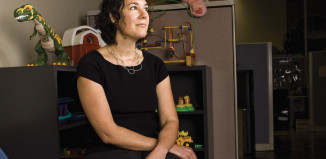It’s a Tuesday night in Austin’s chilly and damp mid-winter, and the air in the Dart Bowl is thick with the scent of enchiladas and the sounds of league night in full swing. At one end of the alley, a bowler in the Porn Flakes has just bowled a strike, and the resounding cheers and high-fives spill over to neighboring teams. Several lanes down, bowlers laugh over beers in plastic, pin-shaped bowling bottles and wander from table to table among teams with names like “Britney Spares” and “Gutter Sluts,” exchanging hellos.
This is a typical night for the Austin Gamblers, the long- running LGBT bowling league that has been rolling since 1986. You won’t see any White Russians or scraggly bowling gurus, but the roughly 70 bowlers here aren’t coming every week for the cultural renaissance the sport is experiencing; they’re here because it’s interesting and it’s social, plain and simple. That’s always been an integral part of the league’s principles, said Steve Schoendienst, the Gamblers’ secretary and treasurer.
“We try to make this league fun,” said Schoendienst. “Everybody’s laid back. It’s not like you go to a bar and everybody’s standoffish, or they don’t talk to you because you’re not pretty enough. We try to leave the attitude at the door.”
The league formed back in the 1980s because there was a large gay population that wanted to get together and do something socially, Schoendienst said, and at the time, bowling was a popular sport. No one among the league’s 20-something teams seems quite sure how or why the Gamblers ended up with their name, which many bowlers admit does little to convey its status as a LGBT league. In fact, the league has a fair number of straight bowlers as well, some of whom wandered in to it because the time slot worked for them, and they had no idea that the league was geared toward the LGBT community.
Describing one such member, League President Ken Diebold said that’s exactly what happened when the male bowler unknowingly joined the Gamblers seven years ago.
“He said he had no idea. He just wanted to bowl at that time slot,” said Diebold. “He’s from where I am, upstate New York in the Buffalo area. So for him coming here, it was quite a change, thinking ‘I’m going to bowl with a bunch of gay people.’ But you don’t even think about it here.”
Diebold and Schoendienst say the bowling community in Austin has been very welcoming of the league and its members, something that Diebold notes the Austin bowlers have learned they sometimes take for granted when they visit other cities when gay bowlers praise the bowling centers.
“Here, we sometimes don’t even think of it; it’s just the way it is,” he said.
At one time, the Gamblers weren’t the only LGBT bowling league in Austin , existing side by side with another group called the Rainbowlers. The two leagues went through several combinations and splits throughout the years before finally combining for good last year.
Now the league, part of the International Gay Bowling Organization, has enough members to nearly fill the Dart Bowl’s lanes each Tuesday night, and is again experiencing an upswing in popularity. Cynthia Brown – Ms. Brown to her league friends and one of the longest-standing members of the league – said of competitiveness ebbs and flows throughout the years, as does the demographics of the league’s members. Right now, there are more young people than ever, she said, something Schoendienst seconds, adding that it is largely due to Austin ’s gay bars starting to take an interest in forming teams.
Rory Meza, who has bowled with the Gamblers for three and a half years and is currently league vice president, said she originally joined after breaking up with a longtime partner, and has stayed put because of the laid-back and friendly atmosphere. Joking that she went from renting equipment to a plastic Kmart® bowling ball and then on to a more professional ball, Meza said league members, even those on opposing teams, encouraged her all the way.
The Gamblers are also a charity league, and that has meant varying levels of involvement in local charities and nonprofits throughout the years. Each league member pays $14 a week to play, and Schoendienst said the Gamblers automatically take $1 of that weekly fee and designate it toward a charity. Members then vote at the end of each season on where to donate the money. (Last year the Gamblers split $2,000 between the David Powell Clinic and Out Youth Austin.) Members also have the option of donating their winnings to charity, although Schoendienst said lately fewer members have opted to do that.
It wasn’t always that way, though. In the 1980s and early 1990s when HIV and AIDS medications weren’t as advanced as they are now, giving to charity was automatic, Schoendienst noted.
“When HIV was such a big thing, and people needed money for that, it was almost compulsory that you gave money to charities,” he said. “Now that it’s a more stable disease, there’s a lot less pressure to do that. But there’s always other places to give to, and in Austin, you can pick so much for the charitable dollar.”




































